15 Day itinerary in Croatia, Europe
Complete Adriatic and Balkans private history tour
Croatia, Bosnia and Herzegovina, Serbia, Northern Macedonia, Albania and Montenegro each boast distinct identity and cultural wonders but similar social openness to guests and travellers. Due to the fragmentation of the Balkans and its turbulent history, each country is fascinating, complex and deep... Read More
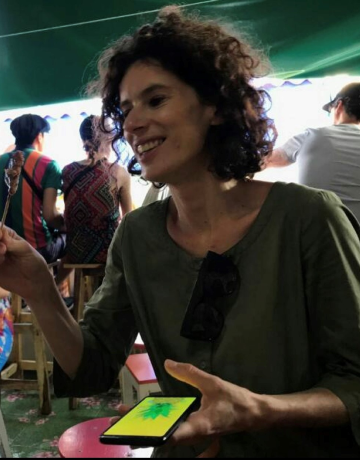

By Tina and Milly
Overview
Physical Difficulty
Easy
Recommended Age
Everyone
Operated in
English
GUIDANCE
On Some Day Trips
starting point
Zagreb
trip type
Private
trip attributes
Culture & History

Night

Highlights
Visit UNESCO protected heritage sites and cities
See best-preserved monuments and buildings of Islamic culture in the Balkans
Explore museums, catholic and orthodox churches
See monuments from two millennia of tremulous history
Visit UNESCO protected heritage sites and cities
See best-preserved monuments and buildings of Islamic culture in the Balkans
Explore museums, catholic and orthodox churches
See monuments from two millennia of tremulous history
Itinerary
Accommodation Categories
Day 1
Arrival to Zagreb
Arrival in Zagreb, the capital of Croatia. After check-in proceed with sightseeing walking tour of Zagreb including Upper Town-historical centre of the city, the Stone Gate, Church of St. Mark with the famed multi-coloured roof, Cathedral (from outside). Overnight at a hotel in Zagreb.
Guide: Included for the day
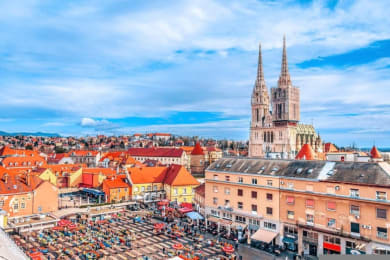
Day 2
Zagreb – Plitvice National Park – Zadar
After breakfast, departure towards Adriatic coast. Stop and sightseeing of Plitvice Lakes National Park, the most famous Croatian national park, registered on UNESCO's List of World Heritage Sites. The park is a magical world of lakes, waterfalls, moss and forests. Entrance fee included. Nestled in the embrace of the surrounding wooded mountains are sixteen smaller and larger crystal turquoise lakes, interconnected by foaming cascades and deep falls. The park includes the headwaters of the Korana River in an area surrounded by dense forests and is additionally ornamented by several caves, springs and flower-filled meadows, which show the vast diversity of flora and fauna in the park. A sightseeing walking tour includes a boat ride and allows you to experience first-hand the magical beauty of the lakes and waterfalls, each spectacular in its own right. Proceed to Zadar, overnight at a hotel.
Guide: Included for the day
Meals: Breakfast
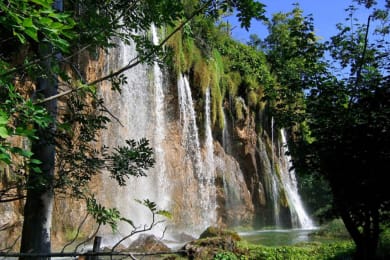
Day 3
Zadar – Šibenik – Split
Breakfast and morning sightseeing tour of Zadar which includes the Cathedral of St. Anastasia, the most impressive basilica in Dalmatia, the church of St. Donat, the ruins of Roman Forum. Proceed south towards Šibenik with the famous Cathedral of St. James. A short sightseeing tour follows. Entrance fees are not included. Šibenik is the oldest Croatian city on the Adriatic with the famous Cathedral of St. James, inscribed on the UNESCO World Heritage site. It is the only cathedral in Europe that is made entirely of stone. You won't find any traces of mortar, wood, iron or roof tiles, even in its complex structural frame. This cathedral is the most important architectural monument in Croatia, dating back to the 15th and 16th centuries, and it was constructed using methods that wouldn't be applied elsewhere until centuries later. Entrance fees are not included. Continue to Split, the „capital of Dalmatia“, famous for Diocletian's Palace which is the most important and preserved Roman building in Croatia, built between AD 295 and AD 305 and registered on the UNESCO List of World Cultural Heritage. Walking tour of the centre of the city is next. Besides the Palace visit to the Peristyle, Cellars, the Temple of Jupiter and the Cathedral of St. Domnius follow. Entrance fees are not included. Overnight at a hotel in Split.
Guide: Included for the day
Meals: Breakfast
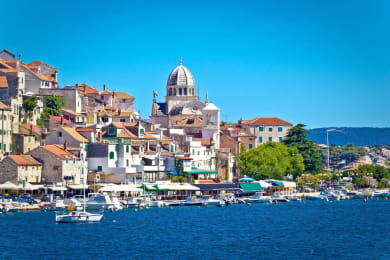
Day 4
Split – Mostar
After breakfast, departure through impressive Croatian and Bosnian landscapes to Mostar. Situated between Sarajevo and Dubrovnik, Mostar is the main centre of Herzegovina and was founded by the Turks in the 15th century. Explore UNESCO protected Old Town, once the centre of the city's Islamic culture and visit Mostar's 14th-century bridge which was destroyed in 1566 and painstakingly rebuilt. The city was named after the guardians of the bridge ("mostari" in Croatian). The Old Bridge is the city’s unique landmark and offers an impressive view of the city. It is also a member of UNESCO World Heritage sites list for Bosnia and Herzegovina (one of total three sites). It was built by the workers from Dubrovnik as ordered by Suleiman the Magnificent and following the project by Hajrudin, the pupil of Sinan, a great Turkish builder from the 16th century. Overnight at a hotel in Mostar.
Guide: Included for the day
Meals: Breakfast
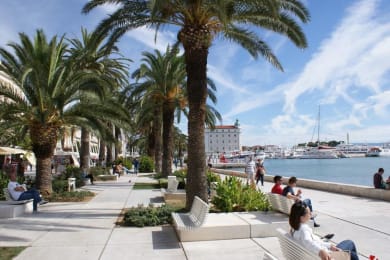
Day 5
Mostar – Sarajevo
After breakfast drive through the beautiful Neretva Valley to Sarajevo, the capital of Bosnia. After arrival, a city tour of the town which has a rich and fascinating culture and which has been home to Muslims, Croats, Turks, Jews and Serbs. The city of many diversities shows the unique link between the East and the West. Visit Baščaršija, old Sarajevo merchant streets from the 15th century, when Isa-bey Isaković founded the entire city, the historical and cultural centre of the city, as well as oriental Svrzina House and Princip Bridge. The word Baščaršija stems from the word "baš", which in Turkish means main so that the word Baščaršija means the main market. The market was categorized and organized based on the crafts so that every street had shops dedicated to one or more complementary crafts (for example the streets called Smiths, Coppersmith, Leathersmiths, Jewellers). Overnight at a hotel in Sarajevo.
Guide: Included for the day
Meals: Breakfast
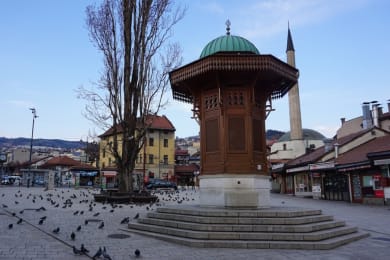
Day 6
Sarajevo – Novi Sad
After breakfast, continue through Eastern Bosnia and Drina river valley to cross the border into Serbia. Entering Serbia you touch Pannonian lowland on the way to Novi Sad. Novi Sad is a city in northern Serbia on the banks of the Danube River. Standing atop a riverside bluff, much of Petrovaradin Fortress dates to the 17th and 18th centuries, with an iconic clock tower and a network of tunnels. Across the river is the old quarter, Stari Grad, the site of the Gothic Revival Name of Mary Church and the Neo-Renaissance City Hall. Entrance fees are not included. Late afternoon arrival, overnight at a hotel in Novi Sad.
Meals: Breakfast
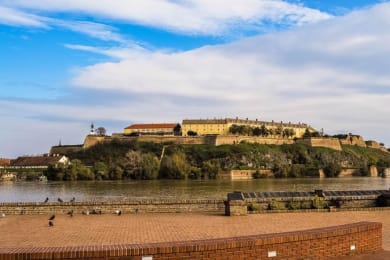
Day 7
Novi Sad – Belgrade
Breakfast and sightseeing of Novi Sad, the second largest city in Serbia with many famous buildings- the University, the National Theatre and Petrovaradin Fortress, which dominates the town. Proceed to Belgrade. On the way to Belgrade, visit the Honey Museum (entrance fee included). The capital of Serbia is situated on the mouth of the river Sava and Danube. You will have a chance to see the famous Belgrade fortress and Kalemegdan, the new socialism-influenced part of the city, the Temple of St. Sava and other sites. Next will be the visit to the final resting place of Marshal Tito, i.e. the House of Flowers, and the Museum of Yugoslavia (entrance fee included). The House of Flowers serves as a mausoleum for Marshal Josip Broz Tito, lifelong president of Yugoslavia, the commander-in-chief in World War II, and one of the founders of the Non-Aligned Movement. Visit of the Military Museum in Kalemegdan established back in 1878 ensues (entrance fee included). The Museum collects, studies and exhibits various objects for military purposes such as arms, uniforms, flags of war, war documentation and logs as well as works of art with a war theme. Surrounded by the city walls and the city's largest park Kalemegdan, the Museum is considered to be one of the symbols of the Belgrade fortress. In the evening you will have dinner at one of the famous restaurants in Belgrade in Skadarlija (accompanied by live music), a bohemian city quarter in central Belgrade. Drinks are not included. Overnight at a hotel in Belgrade.
Guide: Included for the day
Meals: Breakfast, Dinner
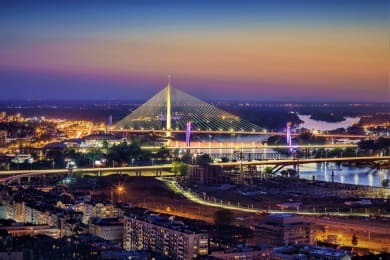
Day 8
Belgrade – Wine Tastings in Šumadija region – Vrnjačka Banja
After breakfast and check-out, travel to Šumadija region, also known as the “heart of Serbia”. Due to its position and historical significance, it is one of the most important agricultural and wine-growing regions in Serbia. Its nickname is “Serbian Tuscany” - its wine tradition and the soft outlines of the hilly terrain is highly reminiscent of the Tuscan region. You will there visit one of the most respected wineries for wine tasting. Šumadija is also known by very prominent figures and events in Serbian history, all of them connected to the Karađorđevic dynasty. You will the visit to the Museum Complex of the Karađorđević family located on the Oplenac hill. It is well known that Karađorđe, the founder of the dynasty, had a vineyard at the very beginning of 19th century. The visit to the vineyard keeper’s house and the Royal winery will be crowned with the famous “Chardonnay” and “Suveren” tasting as well as a look into the wine archive. Continuation of the drive to Vrnjačka Banja. Vrnjačka Banja has many hot springs with temperatures measuring exactly that of the human body. At its hot mineral springs the Romans built the health resort Aquae Orcinae, visited both by legionnaires and aristocracy. The remains of antique pools and thermal waters are preserved to this day. After check-in at the hotel, time at leisure. Overnight at a hotel in Vrnjačka Banja.
Meals: Breakfast, Snacks
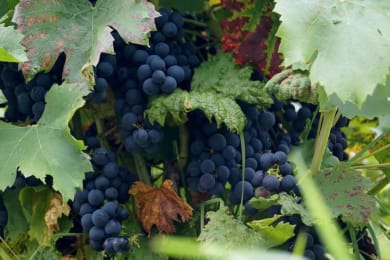
Day 9
Vrnjačka Banja – Skopje
Breakfast and departure for Skopje, the capital of North Macedonia. On the way to Skopje visit of the Monastery Žiča founded by the Serbian King Stefan („the First-Crowned“) at the beginning of the 13th century and Monastery Studenica founded by Stefan Nemanja (who was ordained in that monastery choosing the name Simeon) which is considered to be the crowning achievement of medieval culture and art in Serbia. The trip continues further through the river Ibar valley and the famous Kosovo Polje to Skopje. Overnight at a hotel in Skopje.
Meals: Breakfast
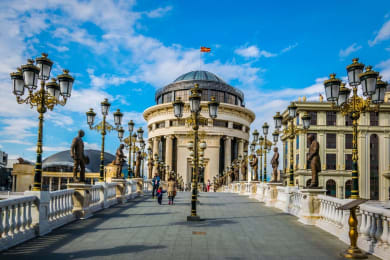
Day 10
Skopje – Ohrid
Breakfast and sightseeing in Skopje. The Vardar River divides the city into two parts: Slavic and Ottoman. Both parts are rich in monuments to be visited: The Stone Bridge, Daut-Pašin Amam (Turkish bath), Feudal Tower, Isa-bey's Mosque, Mustafa-Paša Mosque, Old Skopje Bazaar, Skopsko Kale Fortress, St.Nikita Monastery, St.Spas Church. Whether exploring the many museums, browsing the shops of the old Turkish bazaar or hanging out in a café sipping a macchiato, Skopje will reward the curious in spades. Proceed to to Ohrid. Rightfully referred to as the „Jerusalem of the Balkans“, Ohrid abounds in churches, the walls decorated with wonderful frescoes dating back from 11th, 13th, 14th and 19th centuries. Lying on the shore of the lake with the same name, it is the oldest centre not only for Macedonian culture but for all Slavic nations as well. Settlements around Ohrid, churches along the Ohrid Lake and springs of river Crni Drim complement the magical beauty and attractiveness of Ohrid. Overnight at a hotel in Ohrid.
Guide: Included for the day
Meals: Breakfast
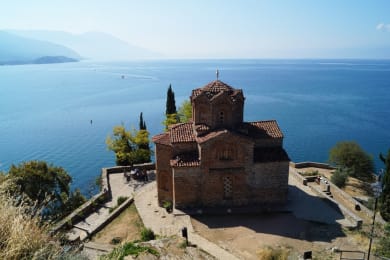
Day 11
Ohrid – Tirana
After breakfast sightseeing of Ohrid and Lake Ohrid (entrance fees are not included). Lake Ohrid is one of the oldest lakes in the world, almost certainly the oldest in Europe, and the deepest too. Not surprisingly, it has a rich history and is a UNESCO World Heritage site, along with the jewel that is Ohrid town. Here you will find churches galore (it is believed that Ohrid once had 365, one for every day of the year) as well as a medieval fortress, a Roman theatre, Ottoman architecture and fine cobbled streets. There is the imposing Samoil's Fortress, the Amphitheater, Gallery of Icons. Proceed to the magnificent Monastery of Saint Naum, an Eastern Orthodox monastery etablished in 905 by St Naum of Ohrid himself, who is buried in the church. Located 30 kilometers south of Ohrid, on a plateau close to the Albanian border and overlooking the Lake of Ohrid, the monastery walls provide breathtaking panoramic views of the entire bay area. Entrance fee is not included. After sightseeing proceed towards Albanian border and continue to Tirana following the steps of Kara Ben Nemsis. Tirana, the capital of Albania, is known for its colourful Ottoman-, Fascist- and Soviet-era architecture. Pastel buildings surround the city's focal point, Skanderbeg Square, which is named for its equestrian statue of a national hero. On the square's north end is the modernist National History Museum, covering prehistoric times through Communist rule and the anti-Communist uprisings of the 1990s. Overnight at a hotel in Tirana.
Meals: Breakfast
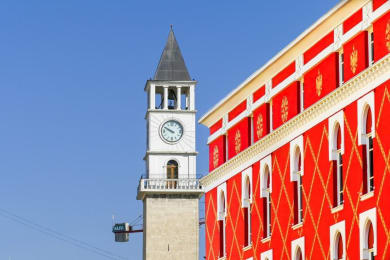
Day 12
Tirana – St.Stefan – Budva
Breakfast and sightseeing of Tirana visiting the most important institutions and different buildings of historic value, two major archaeological collections at the National History Museum and Archaeological Museum, Bazaar. Leaving Albania in the afternoon and crossing the border to enter Montenegro. Drive through the colourful landscape of the Adriatic coast to St.Stefan, a jewel on the Riviera of Budva. In the mid 20th century, the island was renovated and opened in 1960 as a hotel. It quickly became a favourite gathering place for movie stars, royalty, athletes, politicians from the 60s such as Sophia Loren and Carlo Ponti, Doris Day, Princess Margaret, Alberto Moravia. Although you cannot visit the island, you will enjoy walking through the Milocer park filled with olive groves and various exotic trees. The entire amazingly beautiful area was used as the summer residence of the Serbian royal dynasty Karadjordjevic. Next, you will be visiting the Old City of Budva, one of the oldest settlements on the Adriatic. Walking tour of this two and a half millennia old town. The influence of great cultures (Illyrians, Greeks, Romans, Slavs…) shaped the past of this town, while the spirit of ancient times and civilizations can be felt even now. Entrance in Old Town is allowed through one of the five gates, two of which are fully preserved ancient gates. Overnight at a hotel in Budva or Bečići.
Guide: Included for the day
Meals: Breakfast
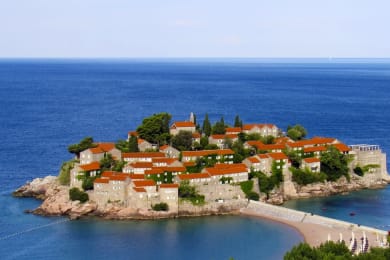
Day 13
Budva - Cetinje – Bay of Kotor – Dubrovnik
After breakfast and check-out sightseeing of Cetinje with two of the most representative buildings: the Monasteries of Cetinje and Bilijarda. Cetinje was founded in the 15th century and became a centre of Montenegrin life and both a cradle of Montenegrin culture and an Orthodox religious centre. Its status as the honorary capital of Montenegro is due to its heritage as a long-serving former capital of Montenegro. Situated in the fields of Cetinje, at the base of the Lovćen mountain, Cetinje is a treasure of Montenegrin cultural and historical heritage. Continue to Tivat, the youngest town in the Bay of Kotor. The town is quite small and colourful and is based around the centre and waterfront. With its position in the Bay of Kotor, numerous coves, peninsula Prevlaka, island St Marco, the famous beach Przno, and the Porto Montenegro marina, Tivat is an exceptionally attractive touristic destination. Next is Perast, the homeland of many world-known sailors and a town whose destiny has always been related to the sea. Its sailors were well-known for their skill and courage. By its lifestyle, it resembled Venice and there are a lot of remains of the old aristocratic palaces that now bear witness to its ancient splendour and richness. Two small picturesque islands are located in front of Perast: St. George (Sv. Djordje) which is a natural island, and Our Lady of the Rock (Gospa od Skrpjela) a manmade island. The island of Our Lady of the Rock was artificially built by piling stones over a sea rock. The church was erected in 1630. The sanctuary was dedicated to the Assumption of the Virgin because this cult was greatly venerated by the Venetians. Most of the present-day church was erected after the great earthquake of 1667 when the original sanctuary was destroyed. Continue to Dubrovnik and overnight at a hotel.
Guide: Included for the day
Meals: Breakfast
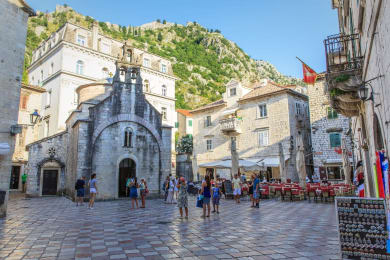
Day 14
Dubrovnik – Cavtat
After breakfast, a city tour of Dubrovnik, the Pearl of the Adriatic. The walls of Dubrovnik girdle a perfectly preserved complex of public, private, sacral and defensive buildings representing all periods of the city's history, beginning with its founding in the 7th century. Famous are the city's main promenade Stradun, the Rector's Palace, the church of St. Blaise, the Cathedral, three large monasteries and the City Hall. The Republic of Dubrovnik was the centre of a separate political and territorial entity, and was proud of its culture, its achievements in commerce and especially of its freedom, preserved down so many tempestuous centuries. In the afternoon visit Cavtat and the native house of Vlaho Bukovac, the great Croatian painter. Overnight at a hotel in Dubrovnik.
Guide: Included for the day
Meals: Breakfast
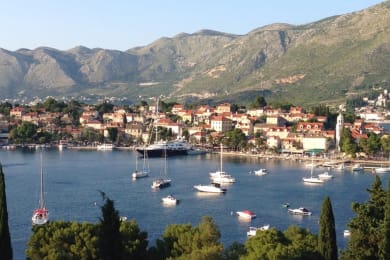
Day 15
Dubrovnik – departure
Breakfast and time at leisure until transfer to the Dubrovnik airport. If you have some spare time, buy some unique souvenirs or gifts- arancini (candied orange peel), sugared almonds or Konavle-style embroidered tablecloth.
Meals: Breakfast
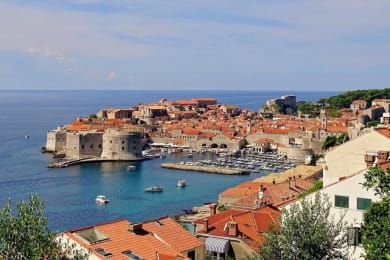
What’s Included
Meals
- Breakfast (14)
- Dinner (1)
- Snacks (1)
Transport
- Transportation during the whole tour with an English-speaking driver
- Transportation costs (fuel, tolls, driver's accommodation and expenses)
Activities
- Guided sightseeing according to the programme, with English-speaking local guides
Extras
- Entrances to the sites mentioned in the programme
- Trip preparation fee
- VAT
Not Included
- International airfare to and from Croatia
- Meals, entrance fees and services other than those specified in the itinerary
- Personal expenses
- Travel insurance
- Gratuities (tips are always appreciated but not mandatory)
About Tina
TEAM LEAD


+1 Local experts
Baboo Certified
Cycling
Hiking
Meet local people
Indigenous culture
Culture & History
Kayak & Canoe
Nature & Wildlife
Food & Culinary
Water & Coastline
My love for nature and animals is growing every day, and caring for the environment has become an essential item of my nature trips. The simplicity of life is the key to his quality and overall happiness. I want to share that with my clients.
Travel that Makes a Difference
By choosing to travel with us, you support local communities, wildlife, and the environment. We are dedicated to positively impacting the world through every journey we offer.

Let’s regenerate the planet together
We overcompensate your entire journey’s carbon footprint including flights - for free.
$3,980.00 USD